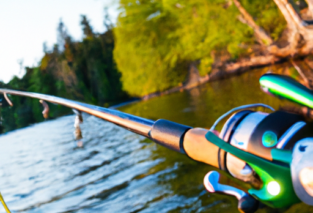You love spending your weekends out on the water, casting your line and waiting for the thrill of a catch. But one thing that always seems to trip you up is figuring out exactly how much fishing line to put on your spool. You don’t want to end up with too much, causing tangles and wasted line, or too little, risking losing that big fish. Fortunately, we’ve got you covered with our helpful guide on measuring the right amount of fishing line for your spool. Say goodbye to guesswork and hello to a seamless fishing experience!

Importance of Measuring Fishing Line
Fishing line is an essential component of any fishing setup, and it is crucial to measure the right amount of line for a successful fishing experience. By measuring the fishing line accurately, you can avoid wasting line and prevent line breaks, ensuring that you are well-prepared for any fishing situation.
Avoiding Wasted Line
One of the primary benefits of measuring fishing line is avoiding wasted line. Fishing line is not cheap, and using more than necessary can result in unnecessary expenses. By measuring the right amount of line, you can minimize wastage and ensure that you have enough line to effectively cast and reel in your catch without excess.
Preventing Line Breaks
Measuring the fishing line also helps prevent line breaks, which can be frustrating and result in lost fish. Overloading the spool with too much line can cause the line to tangle or get trapped, leading to breakage. On the other hand, having insufficient line can result in the fish running out of line quickly, causing breaks from the pressure. By accurately measuring the fishing line, you can avoid these issues and increase your chances of successfully landing your catch.
Factors to Consider
There are several factors to consider when measuring fishing line to ensure you have the right amount. These factors include the type of fishing you will be doing, the fishing techniques you plan to use, the target species of fish, and the spool size of your fishing reel.
Type of Fishing
The type of fishing you engage in plays a significant role in determining the right amount of fishing line. Whether you are freshwater fishing, saltwater fishing, or engaging in fly fishing, each type of fishing requires different line lengths and strengths. It is essential to consider the specific requirements of your chosen fishing style when measuring the fishing line.
Fishing Techniques
Different fishing techniques, such as casting, trolling, or bottom fishing, require varying amounts of fishing line. For example, casting techniques may require longer line lengths to achieve better casting distance, while trolling may require shorter lengths to maintain control over the bait or lure. Understanding the fishing techniques you intend to use will help you determine the appropriate amount of fishing line for your specific needs.
Target Species
The target species of fish also influences the amount of fishing line required. Larger fish species generally require more line capacity to handle their strength and potential long runs. In contrast, smaller fish may not require as much line capacity. Researching the typical size and behavior of your target species will help you determine the appropriate line capacity for your fishing setup.
Spool Size
The spool size of your fishing reel is another crucial factor to consider when measuring fishing line. Different reels come with varying spool capacities, which determine the amount of line they can hold. It is essential to match the amount of line you measure with the spool size of your reel to ensure optimal performance and prevent any line management issues.

Determining the Right Amount of Fishing Line
To determine the right amount of fishing line, you can consider several factors, including the manufacturer’s recommendations, the line capacity of your reel, the type of line you choose, and any knots or leader line you plan to use.
Manufacturer’s Recommendations
Many fishing line manufacturers provide recommendations regarding the amount of line suitable for different types of fishing reels and techniques. These recommendations are a good starting point but may need adjustment based on your personal fishing preferences and needs. Refer to the manufacturer’s guidelines to get a general idea of the right amount of line for your specific reel and fishing style.
Line Capacity of Reel
The line capacity of your fishing reel plays a crucial role in measuring the fishing line accurately. Most reels indicate their line capacity in yards or meters, specifying the maximum amount of line they can hold without compromising performance. It is important to stay within the line capacity specified by your reel to ensure optimal casting, control, and line management.
Choosing the Right Line
The type of line you choose also affects the amount you need to measure. Different types of fishing line, such as monofilament, fluorocarbon, or braided line, have different strengths and diameters. Thicker lines generally require less length to achieve the desired strength, while thinner lines may require more length to compensate for their lower strength. Consider the specific characteristics of the line you choose and adjust your measurements accordingly.
Considering Knots and Leader Line
If you plan to use knots or leader line as part of your fishing setup, it is crucial to account for these additional components when measuring the fishing line. Knots can take up extra line length, so ensure that you have enough line to accommodate the knots required for your specific fishing techniques. Similarly, leader line, which is often attached between the mainline and the lure or bait, should be included in your measurements to ensure optimal fishing performance.
Measuring Fishing Line for Baitcasting Reels
Measuring the fishing line for baitcasting reels requires considering the reel’s line capacity and accounting for backing line if necessary.
Calculating the Line Capacity
To measure the fishing line for a baitcasting reel, start by determining the line capacity specified by the reel manufacturer. This information is typically provided in yards or meters. Based on the manufacturer’s recommendation, measure and spool the line onto your reel accordingly, making sure not to exceed the maximum line capacity to maintain optimal performance.
Accounting for Backing Line
In some cases, adding backing line to your baitcasting reel can increase its line capacity and prevent line slippage. Backing line is a thinner and less expensive line that is spooled onto the reel before adding the mainline. To account for backing line, first, spool an appropriate amount of backing line onto the reel, leaving enough space for the desired amount of mainline. Once the backing line is in place, spool the mainline onto the reel, ensuring you do not exceed the total line capacity specified by the reel manufacturer.

Measuring Fishing Line for Spinning Reels
Measuring the fishing line for spinning reels involves calculating the line capacity and adding backing line if needed.
Line Capacity Calculation
To measure the fishing line for a spinning reel, start by determining the line capacity specified by the manufacturer. This information is typically provided in yards or meters. Use this information as a guide to spool the appropriate amount of line onto your reel, ensuring you do not exceed the maximum line capacity to maintain optimal performance.
Adding Backing Line
Adding backing line to a spinning reel is optional but can increase the line capacity and prevent line slippage. To add backing line, spool an appropriate amount of thinner and less expensive line onto the reel before adding the mainline. Leave enough space for the desired amount of mainline, ensuring you stay within the total line capacity specified by the reel manufacturer. Once the backing line is in place, spool the mainline onto the reel, making sure not to exceed the maximum line capacity.
Measuring Fishing Line for Fly Reels
Measuring the fishing line for fly reels involves matching the line weight and considering various factors specific to fly fishing.
Matching Line Weight
Fly reels are designed to accommodate specific line weights, which are essential for proper balance and casting performance. When measuring fishing line for a fly reel, make sure to match the line weight with the recommended weight range specified by the reel manufacturer. Using the correct line weight ensures optimal casting and reduces the risk of line breaks or failures.
Factors to Consider for Fly Fishing
Fly fishing requires additional consideration when measuring the fishing line, as factors such as casting distance, line visibility, and fishing conditions play crucial roles. Depending on the fishing conditions and the target species, you may need to adjust the line length accordingly. For example, in windy conditions, longer line lengths may be required to maintain control and achieve good casting distance. Consider these factors along with the manufacturer’s recommendations to determine the right amount of fishing line for your fly reel.

Calculating the Ideal Line Length
When calculating the ideal line length, you must consider various factors, including fishing conditions, line visibility, casting range, and leader line considerations.
Fishing Conditions
The fishing conditions, such as the depth of the water, the presence of underwater structures, or the speed of the current, influence the line length required. In situations where you need to reach deeper waters or navigate around obstacles, longer line lengths may be necessary. Conversely, in shallow and open water, shorter line lengths may be sufficient.
Line Visibility
The visibility of the fishing line is another crucial factor to consider when calculating the line length. In clear water conditions, where fish may be more cautious, using longer leader lines or lighter fishing lines can increase your chances of success. However, in murky or heavily vegetated waters, shorter lines or heavier lines may be more appropriate.
Casting Range
The casting range you desire also affects the ideal line length. Longer line lengths allow for greater casting distances, which can be advantageous when trying to reach fish in deeper or more remote locations. Shorter line lengths, on the other hand, provide increased control and accuracy, which may be beneficial in situations where precision casting is required.
Leader Line Considerations
If you plan to use a leader line, factor it into your calculations when determining the ideal line length. Leader lines are often attached to the mainline and help reduce visibility or provide greater strength. Take into account the length of the leader line you intend to use and adjust the measurements accordingly to achieve the desired fishing setup.
Additional Tips and Recommendations
Here are a few additional tips and recommendations to keep in mind when measuring fishing line:
Consider Extra Line for Replacements
It is always a good idea to have extra fishing line on hand for replacements. Accidents happen, lines can break, and having spare line ensures that you can quickly get back to fishing without interruption. Consider purchasing extra line to keep in your tackle box so that you are always prepared.
Consider Line Diameter
Line diameter can affect casting performance and strength. Thicker lines tend to be more visible but offer increased strength, while thinner lines may have better casting distance but may be more prone to breakage. Take into account the specific requirements of your fishing situation and choose a line diameter that balances visibility, strength, and casting performance.
Consult Experienced Anglers
If you are unsure about the right amount of fishing line to measure for a specific fishing setup, do not hesitate to consult experienced anglers or fishing experts. They can provide valuable insights and guidance based on their own experiences and help you make informed decisions when it comes to measuring fishing line.

Conclusion
Measuring the right amount of fishing line is crucial for successful fishing. By avoiding wasted line and preventing line breaks, you can maximize your chances of landing the fish you desire. Considering factors such as the type of fishing, fishing techniques, target species, and spool size, along with manufacturer recommendations and proper line and knot choices, will help you determine the ideal amount of fishing line for your specific needs. Remember to take into account fishing conditions, line visibility, casting range, and leader line considerations for accurate measurements. With these considerations in mind and the tips and recommendations provided, you can confidently measure fishing line to enhance your fishing experience.





